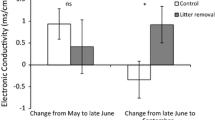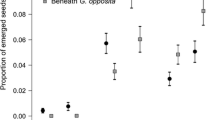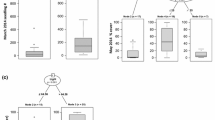Abstract
It is well known that biotic interactions may significantly alter plant population and community dynamics in natural ecosystems. Multiple studies have reported that density-dependent positive interactions can modify the effect of extreme stress on plant performance (in line with predictions by the stress gradient hypothesis, SGH). However, the performance of invasive species and the role of intraspecific density dependence, either negative or positive, in successful invasions are not well understood. In the present study, we tested if monocultures of Rosa multiflora, a highly invasive shrub, experience a group advantage under extremely low water availability. Using a manipulative greenhouse study, we tested the growth response of R. multiflora seedlings to a 4-level conspecific density treatment and a 4-level water availability gradient. Overall, our results provide preliminary evidence that biotic interactions under stressful conditions between R. multiflora individuals do not experience a group advantage, as predicted. Instead, our study indicates that seedling performance was strongly driven by negative density dependence, in which individuals grown at higher conspecific densities displayed lower plant performance, regardless of water availability. This demonstrates that R. multiflora experiences intense intraspecific competition even under a stressful, low resource environment. Thus, management efforts of R. multiflora need to ensure that re-sprouting of individuals after treatment is eliminated, as release from negative density dependence could lead the invader population to rebound.




Similar content being viewed by others
References
Amrine J (2002) Multiflora rose. In: Driesche R, Blossey B, Hoddle M, Lyon S, Reardon R (eds) Biological control of invasive plants in the Eastern United States. USDA Forest Service Publication, New York, pp 265–292
Barrio IC, Hik DS, Bueno CG, Cahill JF (2012) Extending the stress-gradient hypothesis—is competition among animals less common in harsh environments? Oikos 122:516–523. https://doi.org/10.1111/j.1600-0706.2012.00355.x
Bates D, Machler M, Bolker BM, Walker SC (2015) Fitting linear mixed-effects models using lme4. J Stat Softw 67:251–264. https://doi.org/10.18637/jss.v067.i01
Bertness MD, Callaway RM (1994) Positive interactions in communities. Tree 9:27–29. https://doi.org/10.1016/0169-5347(94)90088-4
Bertness MD, Yeh SM (1994) Cooperative and competitive interactions in the recruitment of marsh elders. Ecology 20:249–274. https://doi.org/10.2307/1940895
Brooker RW, Callaghan TV (1998) The balance between positive and negative plant interactions and its relationship to environmental gradients: a model. Oikos 81:196. https://doi.org/10.2307/3546481
Brothers T, S**arn A (1992) Forest fragmentation and alien plant invasion of central Indiana old-growth forests. Conserv Biol 6:91–100. https://doi.org/10.1046/j.1523-1739.1992.610091.x
Bruno JF, Stachowicz JJ, Bertness MD (2003) Inclusion of facilitation into ecological theory. Trends Ecol Evol 18:119–125. https://doi.org/10.1016/S0169-5347(02)00045-9
Buckley YM, Metcalf J (2006) Density dependence in invasive plants demography, herbivory, spread, and evolution. In: Cadotte MW, McMahon S, Fukami T (eds) Conceptual ecology and invasion biology reciprocal approaches to nature. Springer, Dordrecht, pp 109–123. https://doi.org/10.1007/1-4020-4925-0_5
Burns JH, Ardini EA, Schutzenhofer MR, Chung YA, Seidler KJ, Knight TM (2013) Greater sexual reproduction contributes to differences in demography of invasive plants and their noninvasive relatives. Ecology 94:995–1004. https://doi.org/10.1890/12-1310.1
Burns JH, Halpern SL, Winn AA (2007) A test for a cost of opportunism in invasive species in the Commelinaceae. Biol Invasions 9:213–225. https://doi.org/10.1007/s10530-006-9027-3
Callaway RM (2007) Positive interactions and interdependence in plant communities. Springer, Dordrecht
Callaway RM, Thelen GC, Rodriguez A, Holben WE (2004) Soil biota and exotic plant invasion. Nature 427:731–733. https://doi.org/10.1038/nature02322
Callaway RM, Walker LR (1997) Competition and facilitation : a synthetic approach to interactions in plant communities. Ecology 78:1958–1965. https://doi.org/10.1890/0012-9658(1997)078[1958:CAFASA]2.0.CO;2
Cameron GN, Culley TM, Kolbe SE, Miller AI, Matter SF (2016) Relationships between an invasive shrub Amur honeysuckle (Lonicera maackii, Caprifoliaceae) and environmental factors on recruitment of sugar maple trees (Acer saccharum, Aceraceae ) in southwestern Ohio. J Torrey Bot Soc 143:386–397. https://doi.org/10.3159/TORREY-D-15-00036.1
Chen L, Comita LS, Wright SJ, Swenson NG, Zimmerman JK, Mi X, Hao Z, Ye W, Hubbell SP, Kress WJ, Uriarte M, Thompson J, Nytch CJ, Wang X, Lian J, Ma K (2018) Forest tree neighborhoods are structured more by negative conspecific density dependence than by interactions among closely related species. Ecography (Cop) 41:1114–1123. https://doi.org/10.1111/ecog.03389
Clark AT, Detto M, Muller-Landau HC, Schnitzer SA, Wright SJ, Condit R, Hubbell SP (2018) Functional traits of tropical trees and lianas explain spatial structure across multiple scales. J Ecol 106:795–806. https://doi.org/10.1111/1365-2745.12804
Clements FE (1916) Plant succession: an analysis of the development of vegetation. Carnegie Institution of Washington, Washington
Collier MH, Vankat JL, Hughes MR (2002) Diminished plant richness and abundance below Lonicera maackii, an invasive shrub. Am Midl Nat 147:60–71. https://doi.org/10.1674/0003-0031(2002)147[0060:DPRAAB]2.0.CO;2
Daehler CC (2003) Performance comparison of co-occuring native and alien invasive plants: implications for conservation and restoration. Annu Rev Ecol Evol Syst 34:183–211. https://doi.org/10.1146/annurev.ecolsys.34.011802.132403
DiTomaso J, Kyser G (2013) Weed report: Sweetbirar, dog, and multiflora roses. In: Weed control in natural areas in the Western United States. Weed Research and Information Center, University of California, Davis, p 544
Dlugos DM, Collins H, Bartelme EM, Drenovsky RE (2015) The non-native plant Rosa multiflora expresses shade avoidance traits under low light availability. Am J Bot 102:1–9. https://doi.org/10.3732/ajb.1500115
Dohn J, Dembélé F, Karembé M, Moustakas A, Amévor KA, Hanan NP (2013) Tree effects on grass growth in savannas: competition, facilitation and the stress-gradient hypothesis. J Ecol 101:202–209. https://doi.org/10.1111/1365-2745.12010
Drenovsky RE, Khasanova A, James JJ (2012) Trait convergence and plasticity among native and invasive species in resource-poor environments. Am J Bot 99:629–639. https://doi.org/10.3732/ajb.1100417
Ens EJ, French K (2008) Exotic woody invader limits the recruitment of three indigenous plant species. Biol Conserv 141:590–595. https://doi.org/10.1016/j.biocon.2007.12.012
Epstein AH, Hill JH (1999) Status of rose rosette disease as a biological control for multiflora rose. Plant Dis 83:92–101. https://doi.org/10.1094/PDIS.1999.83.2.92
Erskine-Ogden J, Grotkopp E, Rejmánek M (2016) Mediterranean, invasive, woody species grow larger than their less-invasive counterparts under potential global environmental change. Am J Bot 103:613–624. https://doi.org/10.3732/ajb.1500494
Fajardo A, McIntire EJB (2010) Under strong niche overlap conspecifics do not compete but help each other to survive: facilitation at the intraspecific level. J Ecol no-no. 15:25. https://doi.org/10.1111/j.1365-2745.2010.01771.x
Fleury M, Marcelo W, Vásquez RA, González LA (2015) Recruitment dynamics of the relict palm, Jubaea chilensis: intricate nad pervasive effects of invasive herbivores and nurse shrubs in central Chile. PLoS ONE 10:1–13. https://doi.org/10.1371/journal.pone.0133559
Frank GS, Nakatsu CH, Jenkins MA (2018) Soil chemistry and microbial community functional responses to invasive shrub removal in mixed hardwood forests. Appl Soil Ecol 131:75–88. https://doi.org/10.1016/j.apsoil.2018.08.005
Funk JL (2008) Differences in plasticity between invasive and native plants from a low resource environment. J Ecol 96:1162–1173. https://doi.org/10.1111/j.1365-2745.2008.01435.x
Funk JL (2013) The physiology of invasive plants in low-resource environments. Conserv Physiol 1:1–17. https://doi.org/10.1093/conphys/cot026.Introduction
Funk JL, Zachary V, a. (2010) Physiological responses to short-term water and light stress in native and invasive plant species in southern California. Biol Invasions 12:1685–1694. https://doi.org/10.1007/s10530-009-9581-6
García-Cervigón AI, Gazol A, Sanz V, Camarero JJ, Olano JM (2013) Intraspecific competition replaces interspecific facilitation as abiotic stress decreases: the shifting nature of plant-plant interactions. Perspect Plant Ecol Evol Syst 15:226–236. https://doi.org/10.1016/j.ppees.2013.04.001
Goldenheim WM, Irving AD, Bertness MD (2008) Switching from negative to positive density-dependence among populations of a cobble beach plant. Oecologia 158:473–483. https://doi.org/10.1007/s00442-008-1157-0
Gorchov DL, Trisel DE, Ecology SP, Trisel E (2001) competitive effects of the invasive Shrub, Lonicera maackii (Rupr) Herder (Caprifoliaceae), on the growth and survival of native tree seedlings. Plant Ecol 166:13–24. https://doi.org/10.1023/A:1023208215796
Gross N, Liancourt P, Choler P, Suding KN, Lavorel S (2010) Strain and vegetation effects on local limiting resources explain the outcomes of biotic interactions. Perspect Plant Ecol Evol Syst 12:9–19. https://doi.org/10.1016/j.ppees.2009.09.001
Hanula JL, Horn S, Taylor JW (2009) Chinese Privet (Ligustrum sinense) removal and its effect on native plant communities of riparian forests. Invasive Plant Sci Manag 2:292–300. https://doi.org/10.1614/IPSM-09-028.1
Hart SP, Marshall DJ (2013) Environmental stress, facilitation, competition, and coexistence. Ecology 94:2719–2731. https://doi.org/10.1890/12-0804.1
He Q, Bertness MD (2014) Extreme stresses, niches, and positive species interactions along stress gradients. Ecology 95:1437–1443. https://doi.org/10.1890/13-2226.1
He Q, Bertness MD, Altieri AH (2013) Global shifts towards positive species interactions with increasing environmental stress. Ecol Lett 16:695–706. https://doi.org/10.1111/ele.12080
Heberling J, Fridley JD (2016) Invaders do not require high resource levels to maintain physiological advantages in a temperate deciduous forest. Ecology 97:874–884. https://doi.org/10.1890/15-1659.1
Hillerislambers J, Adler PB, Harpole WS, Levine JM, Mayfield MM (2012) Rethinking community assembly through the lens of coexistence theory. Annu Rev Ecol Syst 43:227–248. https://doi.org/10.1146/annurev-ecolsys-110411-160411
Hothorn T, Bretz F, Westfall P (2008) Simultaneous inference in general parametric models. Biom J 50:346–363. https://doi.org/10.1002/bimj.200810425
Kawaletz H, Zerbe S, Annigh P, Ammer C (2013) Exotic tree seedlings are much more competitive than natives but show underyielding when growing together. J Plant Ecol 6:305–315. https://doi.org/10.1093/jpe/rts044
Klionsky SM, Amatangelo KL, Waller DM (2011) Above- and belowground impacts of European buckthorn (Rhamnus cathartica) on four native forbs. Restor Ecol 19:728–737. https://doi.org/10.1111/j.1526-100X.2010.00727.x
Klironomos JN (2002) Feedback with soil biota contributes to plant rarity and invasiveness in communities. Nature 417:67–70. https://doi.org/10.1038/417067a
le Roux PC, McGeoch MA (2010) Interaction intensity and importance along two stress gradients: adding shape to the stress-gradient hypothesis. Oecologia 162:733–745. https://doi.org/10.1007/s00442-009-1484-9
Leger EA, Espeland EK (2010) The shifting balance of facilitation and competition affects the outcome of intra- and interspecific interactions over the life history of California grassland annuals. Plant Ecol 208:333–345. https://doi.org/10.1007/s11258-009-9710-4
Loayza AP, Herrera-madariaga MA, Carvajal DE, García-guzmán P, Squeo FA (2017) Conspecific plants are better ‘nurses’ than rocks: consistent results revealing intraspecific facilitation as a process that promotes establishment in a hyper-arid environment. AoB Plants 9:1–11. https://doi.org/10.1093/aobpla/plx056
Lopez-Iglesias B, Villar R, Poorter L (2014) Functional traits predict drought performance and distribution of Mediterranean woody species. Acta Oecol 56:10–18. https://doi.org/10.1016/j.actao.2014.01.003
Love JP, Anderson JT (2009) Seasonal effects of four control methods on the invasive morrow’s honeysuckle (Lonicera morrowii) and initial responses of understory plants in a southwestern Pennsylvania old field. Restor Ecol 17:549–559. https://doi.org/10.1111/j.1526-100X.2008.00421.x
Luken JO, Tholemeier TC, Kunkel BA, Kuddes LM (1995) Branch Architecture Plasticity of Amur Honeysuckle (Lonicera maackii (Rupr.) Herder): initial response in extreme light environments. Bull Torrey Bot Club 122:190. https://doi.org/10.2307/2996083
Luo W, **e Y, Chen X, Li F, Qin X (2010) Competition and facilitation in three marsh plants in response to a water-level gradient. Wetlands 30:525–530. https://doi.org/10.1007/s13157-010-0064-4
Maestre FT, Callaway RM, Valladares F, Lortie CJ (2009) Refining the stress-gradient hypothesis for competition and facilitation in plant communities. J Ecol 97:199–205. https://doi.org/10.1111/j.1365-2745.2008.01476.x
Marchand P, Houle G (2006) Spatial patterns of plant species richness along a forest edge: what are their determinants? For Ecol Manage 223:113–124. https://doi.org/10.1016/j.foreco.2005.10.064
Matlack GR (1993) Microclimate variation within and among edge sites in the eastern United States. Biol Conserv 66:185–194. https://doi.org/10.1016/0006-3207(93)90004-K
McKinney AM, Goodell K (2011) Plant–pollinator interactions between an invasive and native plant vary between sites with different flowering phenology. Plant Ecol 212:1025–1035. https://doi.org/10.1007/s11258-010-9882-y
Miller KE, Gorchov DL (2004) The invasive shrub, Lonicera maackii, reduces growth and fecundity of perennial forest herbs. Oecologia 139:359–375. https://doi.org/10.1007/s00442-004-1518-2
Molina-Montenegro MA, Badano EI, Cavieres LA (2008) Positive interactions among plant species for pollinator service: assessing the “magnet species” concept with invasive species. Oikos 117:1833–1839. https://doi.org/10.1111/j.0030-1299.2008.16896.x
Murphy JE, Burns JH, Fougère-Danezan M, Drenovsky RE (2016) Functional trait values, not trait plasticity, drive the invasiveness of Rosa sp. in response to light availability. Am J Bot 103:2058–2069. https://doi.org/10.3732/ajb.1600235
Negret BS, Pérez F, Markesteijn L, Castillo MJ, Armesto JJ (2013) Diverging drought-tolerance strategies explain tree species distribution along a fog-dependent moisture gradient in a temperate rain forest. Oecologia 173:625–635. https://doi.org/10.1007/s00442-013-2650-7
Oliveira MT, Matzek V, Medeiros CD, Rivas R, Marinho H, Santos MG (2014) Stress tolerance and ecophysiological ability of an invader and a native species in a seasonally dry tropical forest. PLoS ONE. https://doi.org/10.1371/journal.pone.0105514
Pardini EA, Drake JM, Chase JM, Knight TM (2009) Complex population dynamics and control of the invasive biennial Alliaria petiolata (garlic mustard). Ecol Appl 19:387–397. https://doi.org/10.1890/08-0845.1
Pardini EA, Drake JM, Knight TM (2011) On the utility of population models for invasive plant management: response to evans and davis. Ecol Appl 21:614–618. https://doi.org/10.1890/10-0932.1
Peebles-Spencer JR, Gorchov DL, Crist TO (2017) Effects of an invasive shrub, Lonicera maackii, and a generalist herbivore, white-tailed deer, on forest floor plant community composition. For Ecol Manage 402:204–212. https://doi.org/10.1016/j.foreco.2017.05.053
Perkins LB, Nowak RS (2012) Soil conditioning and plant–soil feedbacks affect competitive relationships between native and invasive grasses. Plant Ecol 213:1337–1344. https://doi.org/10.1007/s11258-012-0092-7
Prasad AE (2012) Landscape-scale relationships between the exotic invasive shrub Lantana camara and native plants in a tropical deciduous forest in southern India. J Trop Ecol 28:55–64. https://doi.org/10.1017/S0266467411000563
Rejmánek M, Richardson DM (2013) Trees and shrubs as invasive alien species - 2013 update of the global database. Divers Distrib 19:1093–1094. https://doi.org/10.1111/ddi.12075
Rhoads AF, Block TA (2011) Multiflora rose invasive species fact sheet. Morris Arboretum, Philadelphia
Richardson DM, Allsopp N, D’Antonio CM, Milton SJ, Rejmánek M (2007) Plant invasions—the role of mutualisms. Biol Rev 75:65–93. https://doi.org/10.1111/j.1469-185X.1999.tb00041.x
Richardson DM, Rejmanek M, Rejmánek M (2011) Trees and shrubs as invasive alien species—a global review. Divers Distrib 17:788–809. https://doi.org/10.1111/j.1472-4642.2011.00782.x
Ruckli R, Rusterholz HP, Baur B (2014) Invasion of an annual exotic plant into deciduous forests suppresses arbuscular mycorrhiza symbiosis and reduces performance of sycamore maple saplings. For Ecol Manage 318:285–293. https://doi.org/10.1016/j.foreco.2014.01.015
Rusterholz HP, Schneuwly J, Baur B (2018) Invasion of the alien shrub Prunus laurocerasus in suburban deciduous forests: effects on native vegetation and soil properties. Acta Oecologica 92:44–51. https://doi.org/10.1016/j.actao.2018.08.004
Schradin K, Cipollini D (2012) The sign and strength of plant-soil feedback for the invasive shrub, Lonicera maackii, varies in different soils. Forests 3:903–922. https://doi.org/10.3390/f3040903
Sheley RL, James JJ (2014) Simultaneous intraspecific facilitation and interspecific competition between native and annual grasses. J Arid Environ 104:80–87. https://doi.org/10.1016/j.jaridenv.2014.01.019
Skálová H, Jarošík V, Dvořáčková Ś, Pyšek P (2013) Effect of intra- and interspecific competition on the performance of native and invasive species of Impatiens under varying levels of shade and moisture. PLoS One 8:e62842. https://doi.org/10.1371/journal.pone.0062842
Soliveres S, Eldridge DJ, Maestre FT, Bowker MA, Tighe M, Escudero A (2011) Microhabitat amelioration and reduced competition among understorey plants as drivers of facilitation across environmental gradients: towards a unifying framework. Perspect Plant Ecol Evol Syst 13:247–258. https://doi.org/10.1016/j.ppees.2011.06.001
Svanfeldt K, Monro K, Marshall DJ (2017) Field manipulations of resources mediate the transition from intraspecific competition to facilitation. J Anim Ecol 86:654–661. https://doi.org/10.1111/1365-2656.12644
Swope SM, Satterthwaite WH, Parker IM (2017) Spatiotemporal variation in the strength of density dependence: implications for biocontrol of Centaurea solstitialis. Biol Invasions 19:2675–2691. https://doi.org/10.1007/s10530-017-1476-3
Tielbörger K, Kadmon R (2000) Temporal environmental variation tips the balance between facilitation and interference in desert plants. Ecolo 81:1544–1553. https://doi.org/10.1890/0012-9658(2000)081[1544:TEVTTB]2.0.CO;2
Ward JS, Williams SC, Linske MA (2018) Influence of invasive shrubs and deer browsing on regeneration in temperate deciduous forests. Can J For Res 48:58–67. https://doi.org/10.1139/cjfr-2017-0208
Ward JS, Williams SC, Worthley TE (2013) Comparing effectiveness and impacts of japanese barberry (Berberis thunbergii) control treatments and herbivory on plant communities. Invasive Plant Sci Manag 6:459–469. https://doi.org/10.1614/IPSM-D-13-00004.1
Winterer J, Walsh MC, Poddar M, Brennan JW, Winterer J, Walsh MC, Poddar M, Brennan JW, Primak SM (2005) Spatial and temporal segregation of juvenile and mature garlic mustard plants (Alliaria petiolata) in a Central Pennsylvania Woodland. Am Midl Nat 153:209–216. https://doi.org/10.1674/0003-0031(2005)153[0209:SATSOJ]2.0.CO;2
Zhang L, Wang B (2016) Intraspecific interactions shift from competitive to facilitative across a low to high disturbance gradient in a salt marsh. Plant Ecol 217:959–967. https://doi.org/10.1007/s11258-016-0621-x
Acknowledgements
We extend a special thanks to our reviewers who have provided helpful and insightful comments on this manuscript, J. S. Medeiros for her participation on J. Murphy’s independent research committee, and C. Cope, A. Faidiga, A. Ósvaldsson, and staff members at Case Western Reserve University’s Squire Valleevue farm for their assistance in experimental set-up and data collection. Experimental funding was provided by the 2014 Invasive Plants Student Research Grant rewarded by the Ohio Invasive Plant Council (OIPC).
Author information
Authors and Affiliations
Corresponding author
Additional information
Communicated by Peter le Roux.
Publisher's Note
Springer Nature remains neutral with regard to jurisdictional claims in published maps and institutional affiliations.
Electronic supplementary material
Below is the link to the electronic supplementary material.
Rights and permissions
About this article
Cite this article
Murphy, J.E., Burns, J.H. Rosa multiflora’s performance under water stress: the role of positive and negative density-dependent intraspecific interactions. Plant Ecol 220, 951–963 (2019). https://doi.org/10.1007/s11258-019-00965-6
Received:
Accepted:
Published:
Issue Date:
DOI: https://doi.org/10.1007/s11258-019-00965-6




